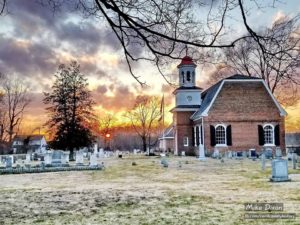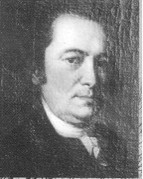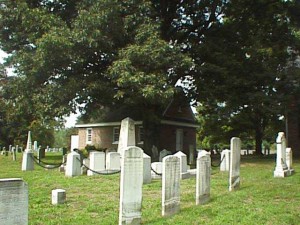 In 1706, owing to the lack of the established church on the northern shore of the Elk River, the colonial legislature and governor of Maryland established the North Elk Parish. As was the custom in England, the Lord of the Manor on which the parish was to be located, in this case, Henry Harford, the illegitimate son of Frederick, Lord Baltimore, set aside four acres of land for the establishment of the church buildings. Early survey maps indicate that sometime between 1709 and 1715 a wooden church was built on this land, the site of the present church, but no details about this first building are known.
In 1706, owing to the lack of the established church on the northern shore of the Elk River, the colonial legislature and governor of Maryland established the North Elk Parish. As was the custom in England, the Lord of the Manor on which the parish was to be located, in this case, Henry Harford, the illegitimate son of Frederick, Lord Baltimore, set aside four acres of land for the establishment of the church buildings. Early survey maps indicate that sometime between 1709 and 1715 a wooden church was built on this land, the site of the present church, but no details about this first building are known.
The Reverend Jonas Auren, a Swedish Lutheran clergyman, came to New Sweden late in the 1600’s and stayed in America until his death in 1713. Most of this time he was in Cecil County (founded in 1674), preaching for a congregation of English, Swedes, and Finns. This congregation became the congregation of St. Mary Anne’s, and the Rev. Mr. Auren its first Rector.
In 1743, the Vestry contracted with Henry Baker for the building of a brick church, at a cost of 300 pounds, to replace the old wooden structure. A detailed description of this building can be found in the minutes of the Vestry dated March 1, 1743, and, except for the bell tower, which was added later.
The cornerstone at the southwest corner of the building contains the initials of the rector and Vestry members of the time and date, 1743. The names are as follows: The Reverend William Wye (rector), John Currer, Zebulon Hollingsworth, Nicholas Hyland, Henry Baker, Edward Johnson, and Thomas Ricketts.
It was during this period that the parish was supplied with a large parcel of property known as glebe land. This land, about 100 acres near Charlestown, was held in trust by the Vestry and worked by a farmer to provide funds to support a minister. Additional money for church support was obtained through taxation of local landowners. The Vestry also had responsibility for matters of morality in the community, especially “illegal cohabitation”.
The first mention of the War for American Independence appeared in the Vestry minutes in September 1777 when, following the landing of Howe’s troops on the shore of the Elk River on their way to capture Philadelphia, the minutes stated: “The English appear’s in our Rivers and Bays and our Vestry thereby being disturbed could not meet and therefore cannot be accountable for any Fines imposed”. The next year, the Rector, the Rev. William Thompson left suddenly and without explanation, perhaps leaving the colonies for England or Canada, as many Anglican clergy did, because they could not swear the Oath of Allegiance to the revolutionary cause (and against the King) without, they believed, violating their vows of ordination. For the next years, the church was without a rector and services were led by lay readers. The most notable of these was Mr. Joseph Coudon. He was urged by the Vestry to seek ordination, and, in May of 1787, Coudon became the first priest ordained in America by Bishop White of Pennsylvania. He served as rector until his death in 1792. There is a monument to the Rev. Mr. Coudon in the chancel of the church.
In the first part of the 19th century, the fortunes of St. Mary Anne’s followed an up and down path. The Church was often without a rector and the records show the properties to be in a state of disrepair. The last half of the century found the Church to be on a much more solid footing. This was likely due to the long term of service of two veterans of the Civil War. The Rev. Enoch K. Miller, a Union Chaplain was the rector for seventeen years. He was succeeded by the last surviving member of the staff of General Robert E. Lee, the Rev. Giles B. Cooke.
The architecture of the church building is typical of the mid-eighteenth century colonial America, but the combined gambrel and hip roof is unusual. The walls are 3-4 bricks thick and on the south side laid in the Flemish Bond style, with dark accents. The original small-pane windows were replaced in the last century, as were the shutters and the old stall pews and most of the remainder of the interior. Recently, the shutters were restored to their original style, but the interior furniture and design is entirely Victorian or modern.
The bell tower was built in 1904 by the Brookings family in memory of Robert S. Brookings, founder of the Brookings Institute in Washington, D.C. The tower replaced an earlier wooden structure at the west door.
 There are many old and interesting tombstones in the churchyard, although time has made some of the inscriptions illegible. The small stones behind the Vestry house are thought to mark the graves of Native Americans. Jeremiah Baker, who fought in the Revolution with Washington at Monmouth, is buried near the Vestry House, and there are many markers for the Coudon family, which has been active in the parish to the present time. In fact, on September 28, 2008, Joseph Couden IX was baptized at the 10:30 service!
There are many old and interesting tombstones in the churchyard, although time has made some of the inscriptions illegible. The small stones behind the Vestry house are thought to mark the graves of Native Americans. Jeremiah Baker, who fought in the Revolution with Washington at Monmouth, is buried near the Vestry House, and there are many markers for the Coudon family, which has been active in the parish to the present time. In fact, on September 28, 2008, Joseph Couden IX was baptized at the 10:30 service!
In times past, stores, house, a saloon, and even (it is said) a brothel occupied part of the land which is now the churchyard. Vestry minutes record that it was the official duty of the rector to go into the saloon no later than 10 o’clock on Saturday evening to clear out all those who “part-took of too much of the evil beverages”. This duty is no longer required of the rector!
The Vestry House, historically the place where the colonial vestries carried out their civil and church duties, is of recent construction, but is patterned after similar original colonial buildings at other parishes. Other parish buildings include the old sexton’s house, across Church Point Road, and the parish house and rectory, of modern construction, adjacent to the churchyard to the north.